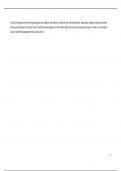Samenvatting
Samenvatting/cursus: Introduction to GIS (Theory)
- Instelling
- Vrije Universiteit Brussel (VUB)
Samenvatting op basis van 15 mogelijke examenvragen voor het theorie-examen van Introduction to GIS. Iedere vraag wordt beantwoord alsook achtergrondinformatie om de context van de vraagstelling te begrijpen.
[Meer zien]












